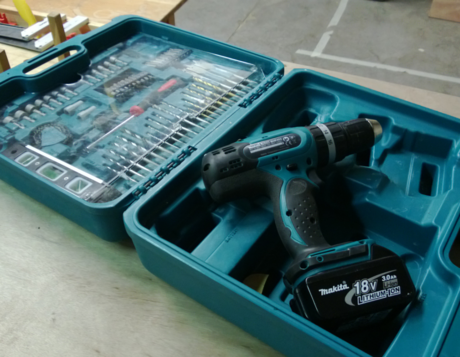Difference between revisions of "Equipment/BDF453RFE"
Perfectphase (Talk | contribs) |
Perfectphase (Talk | contribs) |
||
| Line 1: | Line 1: | ||
| + | [[Equipment|Equipment]] / Cordless Drill | ||
| + | |||
| + | [[File:Cordless drill.PNG|thumb|460px|right|Cordless Drill]] | ||
= Summary = | = Summary = | ||
Revision as of 06:23, 30 March 2013
Equipment / Cordless Drill
Contents
Summary
A power drill is an electrical motor that rotates a replaceable drill bit to make a hole in wood, plastic, or metal. Alternately, a screwdriver tip can be installed to turn screws. The parts of a power drill include the handle, an on/off trigger with safety latch, a reversing switch for changing the rotation direction of the drill bit, a torque adjustment, and the chuck that holds the drill bit in place.
Owners
Health and Safety
Sharp Object/material
- All drills to be kept in their holders until they are required.
- Power supply to be disconnected when changing drill bits.
- Wait for the drill bit to stop moving before putting the tool down.
Slips, Trips and Falls
- Waste material/offcuts to be kept clear of work area.
Fire
- Equipment will be checked for defects before each use to minimise the risk of possible electrical faults or fire.
- Carbon Dioxide extinguisher to be available for any electrical fires
Electric shock
- The equipment will be checked before each use to ensure that there are no defects in the casing, battery or cutting head.
Sight/Noise/Dust/Vibration
- P.P.E. to be worn when using the equipment.
- Regular brakes to prevent fingers becoming numb
Repetitive Action/Physical Fatigue
- Regular breaks if work is lasting more than 5 minutes in duration
Training
Instructions
If you've never used a portable drill before, please watch this video first Drill Safety & operation (Video)
Please refer to the product manual for detailed instructions on how to use the router. A printed copy is also kept with the router. File:BHP452 OM.pdf
Always always, always check for any electricity cables running through the wall before you start drilling. Catching a live cable when drilling is potentially fatal so it's worth taking the extra time to check. You can buy an AC detector from most DIY stores and depending on the make it will buzz or flash when it locates a cable on in the wall.
Never wear loose clothing or dangling jewelry which could catch in the drill as you lean over it. And always wear eye goggles to protect yourself from flying dust and debris as the drill goes into the wall.
The drill bit will become hot with use so keep you hands off it. Unplug the drill before changing bits. And don't forget to remove the chuck key before switching on the drill.
Make sure you use the correct drill bit for the type of wall you are drilling into. For example use a masonry drill bit for solid brick walls, a wood bit for timber and a high-speed steel bit for metal.
If you are drilling into tiles use a specialist tile drill bit and stick a little piece of masking tape over the area to stop the drill from wandering.
If you are drilling into plasterboard, tap the wall to find where it is not hollow as this will be where the wooden joist is - aim to drill only into this. Or to be completely accurate just use a joist detector.
Tips & Tricks
- Keep work area clean and well lit. Cluttered and dark areas invite accidents.
- Keep bystanders away while operating a power tool. Distractions can cause you to lose control.
- Do not expose power tools to rain or wet conditions. Water entering a power tool will increase the risk of electric shock.
- Remove any adjusting key or wrench before turning the power tool on. A wrench or a key left attached to a moving part of the power tool may result in personal injury.
- Do not overreach. Keep proper footing and balance at all times. This enables better control of the power tool in unexpected situations.
- Dress properly. Do not wear loose clothing or jewellery. Keep your hair, clothing, and gloves away from moving parts.
- Avoid cutting nails. Inspect work piece for any nails and remove them before operation.
- Tips for maintaining maximum battery life
- Charge the battery cartridge before completely discharging.
- Always stop tool operation and charge the battery cartridge when you notice less tool power.
- Never recharge a fully charged battery cartridge. Overcharging shortens the battery service life.
- Let a hot battery cartridge cool down before charging it.
Maintenance
Every month inspect for damage and general wear and tear and asses state of stock blades and replace as needed.
